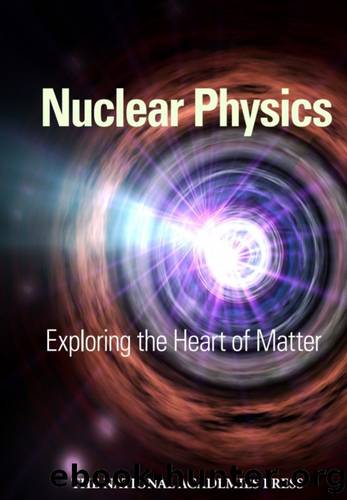Nuclear Physics: Exploring the Heart of Matter by Council National Research

Author:Council, National Research [Council, National Research]
Language: eng
Format: epub
Publisher: UNKNOWN
Published: 2020-11-21T16:00:00+00:00
FIGURE 2.33 Left: The masses of the light hadrons, including the lowest lying baryons beginning with protons and neutrons, as predicted by lattice QCD. Right: Elements of JLABâs computing facilities for lattice QCD. SOURCE: (Left) From S. Dürr, Z. Fodor, J. Frison, C. Heolbling, et al., 2008, Science 322: 1224. Reprinted with permission from AAAS; (right) courtesy of JLAB.
experimental efforts like GlueX and experiments at FAIR. Progress will come from both significant developments in theory and methodology, but additional investments in state of the art supercomputing facilities will also be required.
Lattice QCD is also being used to understand other aspects of hadronic structure. Calculations of electromagnetic transitions between excited states are another useful connection to experiment. Radiative transitions in charmed mesons have already been calculated, and applications to other systems will come in the next decade. The calculations can be compared with experimental results from CLEO, providing an ideal test bed for the validity of the theoretical approaches used. In the years to come they will be refined and extended to the light quark sector, providing theoretical input to the upcoming experiments.
Toward the Next Steps: An Electron-Ion Collider
An important next step in nuclear physics will be to connect studies of the quark/gluon structure of nucleons with the study of complex nuclei, by determining how the deep internal structure of nucleons is affected when the nucleons are bound inside nuclei. The nuclear physics community has studied extensively the science that a future electron-ion collider (EIC) could enable with a combination of relatively high center-of-mass energy, high luminosity, and polarized electron beams colliding with beams of polarized protons, light ions, and heavy nuclei. While the technical parameters of an EIC have yet to be finalized with respect to specific science goals, the energy would likely be lower than that of HERA, but the
131
2-34.eps
some type outlined
Landscape
intensity would be as much as 1,000-fold higher and, unlike HERA, the EIC would use nuclear and polarized beams in the collision. Such a capability would provide groundbreaking reach to low momentum partons in the proton and nuclei in the same fashion that the JLAB 12 GeV upgrade can probe the valence quark region of the nucleons and nuclei. An EIC would also provide direct access to the dynamics of the complex system of strongly interacting quarks and gluons that result in the protonâs spin. This includes orbital motion, the importance of which research at JLAB and RHIC and within the HERMES experiment has made apparent. Quark orbital motion leads not only to angular momentum but also to significant quark transverse motion in the proton. An EIC would permit access to the transverse distributions, allowing the development of a multidimensional (in space and momentum) image of the sea quarks and gluons. Finally, as mentioned above, an EIC would permit a first serious look at the gluonic structure of the proton and the nucleus, including the remarkable glass-like characteristics expected for the lowest momentum gluons in protons and nuclei.
FUNDAMENTAL SYMMETRIES
At the end of the nineteenth century, physicist Albert A.
Download
This site does not store any files on its server. We only index and link to content provided by other sites. Please contact the content providers to delete copyright contents if any and email us, we'll remove relevant links or contents immediately.
| Atomic & Nuclear Physics | Particle Physics |
The Complete Stick Figure Physics Tutorials by Allen Sarah(7339)
Secrets of Antigravity Propulsion: Tesla, UFOs, and Classified Aerospace Technology by Ph.D. Paul A. Laviolette(5335)
Thing Explainer by Randall Munroe(3910)
The River of Consciousness by Oliver Sacks(3572)
The Order of Time by Carlo Rovelli(3163)
How To by Randall Munroe(3075)
A Brief History of Time by Stephen Hawking(2994)
I Live in the Future & Here's How It Works by Nick Bilton(2961)
What If?: Serious Scientific Answers to Absurd Hypothetical Questions by Randall Munroe(2670)
The Great Unknown by Marcus du Sautoy(2663)
Midnight in Chernobyl by Adam Higginbotham(2519)
Blockchain: Ultimate Step By Step Guide To Understanding Blockchain Technology, Bitcoin Creation, and the future of Money (Novice to Expert) by Keizer Söze(2467)
Networks: An Introduction by Newman Mark(2382)
The Meaning of it All by Richard Feynman(2319)
Easy Electronics by Charles Platt(2309)
The Tao of Physics by Fritjof Capra(2247)
Midnight in Chernobyl: The Untold Story of the World's Greatest Nuclear Disaster by Adam Higginbotham(2198)
When by Daniel H Pink(2098)
Introducing Relativity by Bruce Bassett(2097)
